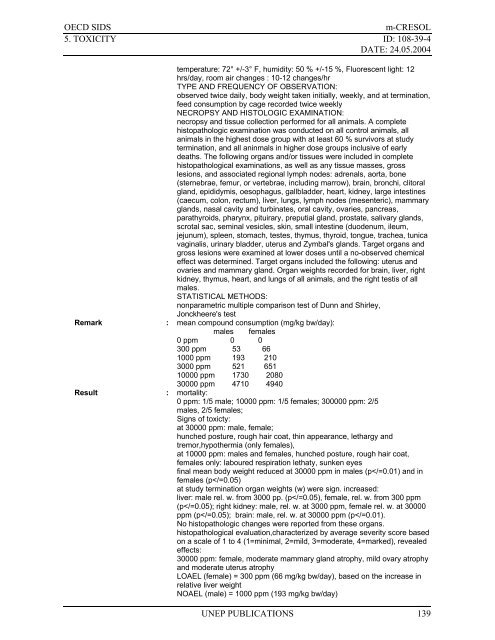m-Cresol - ipcs inchem
m-Cresol - ipcs inchem
m-Cresol - ipcs inchem
You also want an ePaper? Increase the reach of your titles
YUMPU automatically turns print PDFs into web optimized ePapers that Google loves.
OECD SIDS<br />
m-CRESOL<br />
5. TOXICITY ID: 108-39-4<br />
DATE: 24.05.2004<br />
temperature: 72° +/-3° F, humidity: 50 % +/-15 %, Fluorescent light: 12<br />
hrs/day, room air changes : 10-12 changes/hr<br />
TYPE AND FREQUENCY OF OBSERVATION:<br />
observed twice daily, body weight taken initially, weekly, and at termination,<br />
feed consumption by cage recorded twice weekly<br />
NECROPSY AND HISTOLOGIC EXAMINATION:<br />
necropsy and tissue collection performed for all animals. A complete<br />
histopathologic examination was conducted on all control animals, all<br />
animals in the highest dose group with at least 60 % survivors at study<br />
termination, and all aninmals in higher dose groups inclusive of early<br />
deaths. The following organs and/or tissues were included in complete<br />
histopathological examinations, as well as any tissue masses, gross<br />
lesions, and associated regional lymph nodes: adrenals, aorta, bone<br />
(sternebrae, femur, or vertebrae, including marrow), brain, bronchi, clitoral<br />
gland, epididymis, oesophagus, gallbladder, heart, kidney, large intestines<br />
(caecum, colon, rectum), liver, lungs, lymph nodes (mesenteric), mammary<br />
glands, nasal cavity and turbinates, oral cavity, ovaries, pancreas,<br />
parathyroids, pharynx, pituirary, preputial gland, prostate, salivary glands,<br />
scrotal sac, seminal vesicles, skin, small intestine (duodenum, ileum,<br />
jejunum), spleen, stomach, testes, thymus, thyroid, tongue, trachea, tunica<br />
vaginalis, urinary bladder, uterus and Zymbal's glands. Target organs and<br />
gross lesions were examined at lower doses until a no-observed chemical<br />
effect was determined. Target organs included the following: uterus and<br />
ovaries and mammary gland. Organ weights recorded for brain, liver, right<br />
kidney, thymus, heart, and lungs of all animals, and the right testis of all<br />
males.<br />
STATISTICAL METHODS:<br />
nonparametric multiple comparison test of Dunn and Shirley,<br />
Jonckheere's test<br />
Remark : mean compound consumption (mg/kg bw/day):<br />
males females<br />
0 ppm 0 0<br />
300 ppm 53 66<br />
1000 ppm 193 210<br />
3000 ppm 521 651<br />
10000 ppm 1730 2080<br />
30000 ppm 4710 4940<br />
Result : mortality:<br />
0 ppm: 1/5 male; 10000 ppm: 1/5 females; 300000 ppm: 2/5<br />
males, 2/5 females;<br />
Signs of toxicty:<br />
at 30000 ppm: male, female;<br />
hunched posture, rough hair coat, thin appearance, lethargy and<br />
tremor,hypothermia (only females),<br />
at 10000 ppm: males and females, hunched posture, rough hair coat,<br />
females only: laboured respiration lethaty, sunken eyes<br />
final mean body weight reduced at 30000 ppm in males (p
















